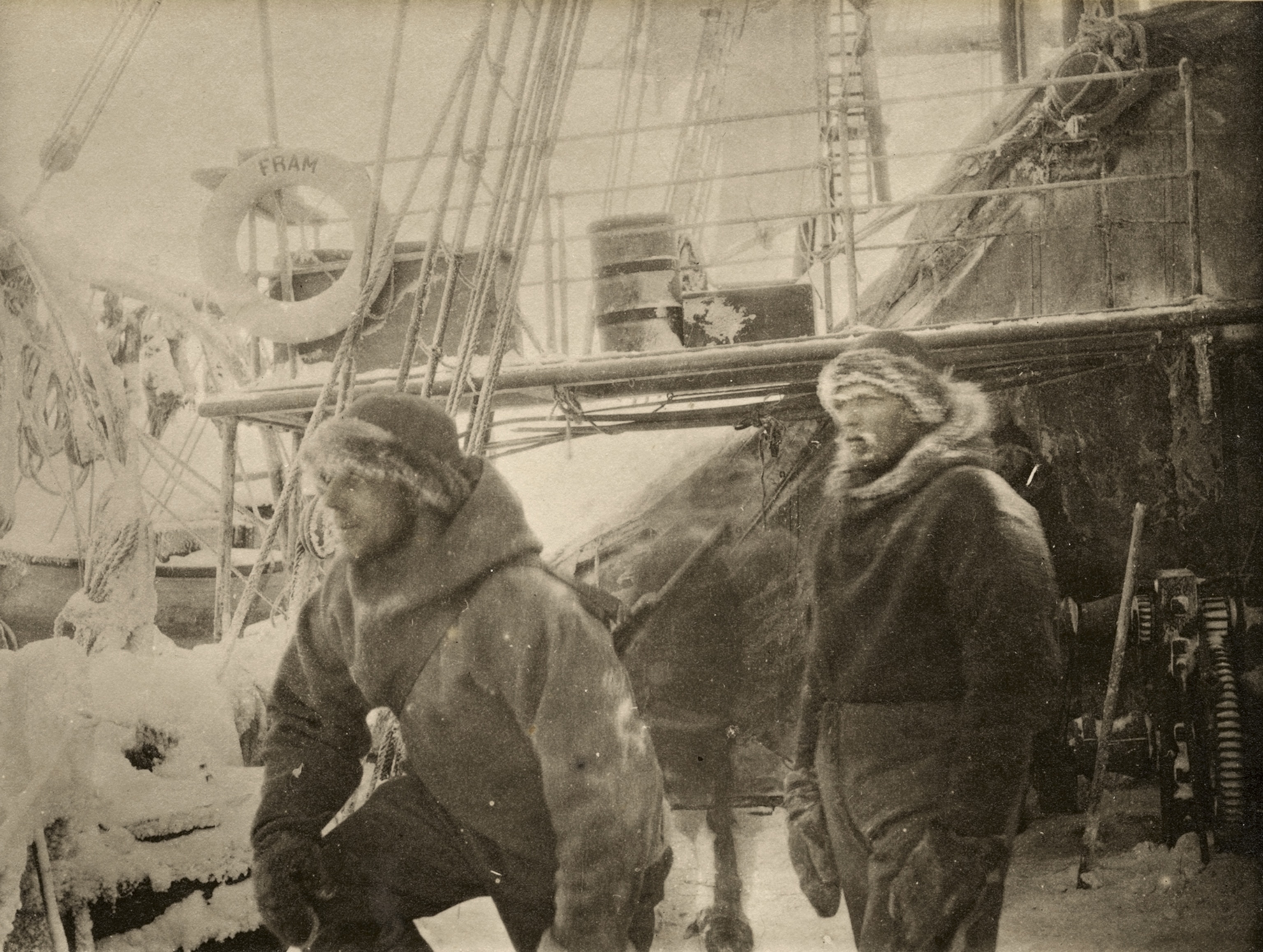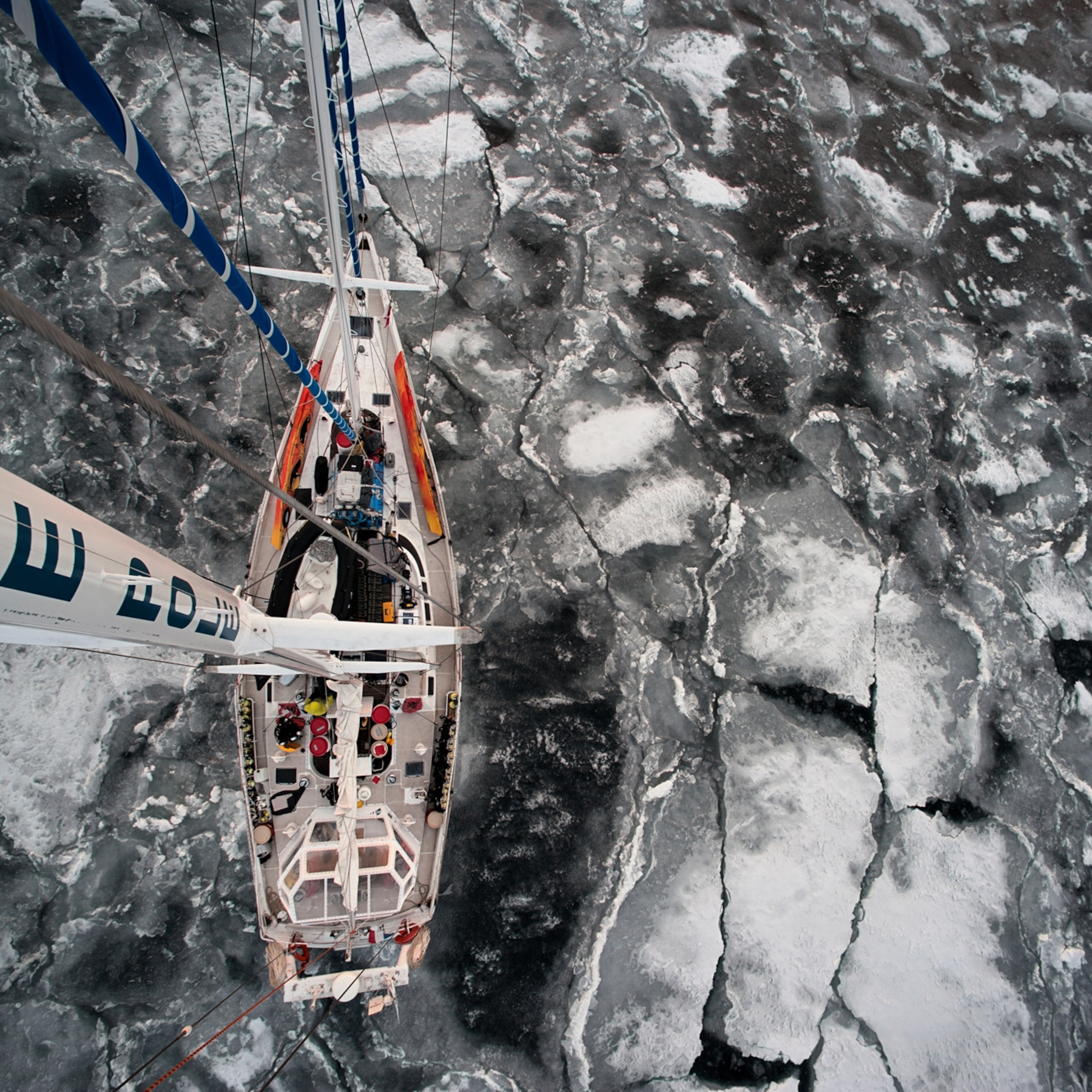
1,000 Days in the Ice
Norway’s Fridtjof Nansen was a pioneer of polar exploration.
Out in the cold fjord, on a spit of rocky land just a short ferry ride from the city center, Oslo has created a kind of national cemetery for famous ships. It's a Norwegian thing—what other country would build public crypts around its most beloved boats and enshrine them for the ages? Out here on the Bygdøy Peninsula, visitors can spend days rambling through splendid museums that house ancient Viking longships, 19th-century fishing vessels, even Thor Heyerdahl's famed balsa wood raft, the Kon-Tiki.
But the most striking of Oslo's nautical temples is a pointy glass-and-metal structure that rises from the waterline in the shape of an enormous letter A. Inside, basking in the filtered light, sleeps a sturdy wooden schooner, built in 1892, called the Fram.
Fram (which means "forward") is perhaps the most famous ship in Norway's long seafaring history, and an icon of polar exploration. Nothing about this fat-bellied ark would begin to suggest the grueling odysseys it has endured. The story of the Fram is a modern Norse saga, a story of unimaginable hardship and intelligent striving that is closely tied to Norwegian national identity. The boat itself is an engineering marvel—its reinforced hull having withstood three years gripped by Arctic ice. True to its assertive, full-frontal name, Fram bored farther into the frozen latitudes than any vessel had before.
The prime mover behind the Fram, the brilliant and moody scientist-explorer who commissioned its construction and led its insanely dangerous maiden voyage into the polar mists, remains a national patriarch. His name is Fridtjof Nansen, and although today he is not as well-known outside Norway as other marquee polar adventurers—Peary, Scott, and Amundsen—he should be. For Nansen was quite simply the father of modern polar exploration; all others were, in a very real sense, his acolytes.
Nansen was a strapping blond man, fair complected, with a frosty stare and a truculent face that seemed slightly at odds with the refinements of his intellect. Nansen stood apart from the quixotic glory hounds who characterized much of polar exploration's golden age. Call him a Renaissance Viking: He was a gifted writer, a sought-after lecturer, a first-rate zoologist, and a prominent statesman. Fluent in at least five languages, adroit with a camera, he made beautiful maps and illustrations, kept up a voluminous scientific correspondence, and brought an element of cerebral precision to all his explorations. A contemporary German scientist said of Nansen that he "knew how to handle the microscope as well as the ice axe and skis," and his scientific achievements were notable, including a groundbreaking paper on the nature of the central nervous system.
In 1888 Nansen led the first traverse of Greenland—with typical understatement, he called it a "ski tour"—but he missed the last boat home, forcing him to stay the winter hunting seals, learning to kayak, and living with Greenlanders. This experience formed the basis for his acclaimed account, The First Crossing of Greenland, published in 1890, and a lively ethnology, Eskimo Life. Following his Greenland adventures, he became a leading proselytizer for the sport of skiing. At Oslo's Holmenkollen Ski Museum, Nansen is depicted as a twin-planked deity in furs, a founding father of Norway's national sport.
For all of Nansen's protean accomplishments, it was the harrowing journey of the Frambetween 1893 and 1896 that gave his life story real drama. The expedition was predicated on an idea so outlandish that the leading polar authorities of the day, including the Royal Geographical Society, considered it suicidal. Nansen deliberately set out to become locked in the Arctic—or, as he put it, to "give ourselves up to the ice."
Nansen sought to improve upon the voyage of an earlier polar exploration that had ended in disaster. In 1879 the American ship U.S.S. Jeannette became locked in the ice pack above Siberia. It drifted in the Arctic for 21 months, but was eventually crushed by the pressure, and sank on June 13, 1881. Although the crew made a valiant sprint for Siberia, more than half the 33 men on the expedition perished. However, three years later, artifacts from theJeannette were found washed up on the coast of Greenland after having drifted thousands of miles in the ice.
Reading about the Jeannette artifacts, Nansen wondered if the strong east-to-west current over the Arctic could be ridden to the North Pole—or at least close. And so an idea was hatched. It was an unorthodox notion, says Nansen biographer Roland Huntford, "to take note of the forces of nature, and try to work with them and not against them."
The trick, of course, was to build a boat far tougher than the Jeannette, and in 1891 Nansen hired a brilliant Norwegian naval architect of Scottish descent named Colin Archer to do just that. Archer's design featured a curiously rounded hull that lacked a pronounced keel, and wells that allowed the rudder and propeller to be hauled up to safety in the event of crushing ice. The hold of the ship was braced with mighty timbers. To keep the explorers warm, Nansen insulated his vessel with thick felt, reindeer hair, cork shavings, and tar. To fight off the perpetual blackness of the polar night, a windmill was installed to run electric arc lamps. Belowdecks were a cozy saloon decorated with carved dragon's heads and a library that Nansen stocked with some 600 carefully chosen volumes.
Nansen pronounced the vessel fit, and with thousands of well-wishers lining the Oslo harbor, his wife, Eva, christened the ship Fram. With a crew of 13 and provisions for five years, Nansen left Oslo in the summer of 1893, bound for the New Siberian Islands.
As expected, the Fram became locked fast in the ice in September. The pressure was intense, and the constant churning and scraping of the ice made ghastly sounds. "A deafening noise began, and the whole ship shook," Nansen wrote. "The noise steadily grows till it is like all the pipes of an organ." The ice, he wrote two days later, "is trying its very utmost to grind theFram into powder ." But the Fram easily withstood all this frightful squeezing and simply rose up, unharmed, from the depths of the ice. Over time Nansen came to "laugh at the ice; we are living as it were in an impregnable castle."
The Fram continued to ride the floes toward the Pole at the creaky pace of a few miles a day. Despite several mishaps—including a polar bear attack that ended with one crewman bitten and two dogs dead—the first two years of the journey were oddly easy. The men ate well in the bright, warm saloon—where an automatic organ played through the long Arctic nights and the electric lamps, Nansen wrote, "acted on our spirits like a draught of good wine." The men published their own newspaper, organized ski outings on the ice for exercise, and took endless soundings and other measurements. Boredom was a constant companion—one crewman cursed "the monastic life we lead in this dead zone"—but Nansen's men did not suffer. "I myself," he wrote, "have certainly never lived a more sybaritic life."
Early in the second year, however, it became apparent that Framwould not reach the Pole. To achieve his goal, Nansen would have to get out on the ice with sleds and dogs and make a dash for it. He selected a companion, Hjalmar Johansen, and in March of 1895, after two false starts, they left the comfort of the Fram. A cannon volley boomed as the two skiers, dragging three sleds, carrying two kayaks, and accompanied by 28 dogs, headed north. Nansen and Johansen soon ran into trouble—impossible terrain, equipment failures, fast-shifting floes that canceled out their progress. As their provisions dwindled, they began to butcher the weakest dogs to feed the others. By April they had traveled as far north as they could go—86° 14 N. Although they were still 226 miles shy of the Pole, they had ventured farther north than any human ever had. It was the largest single advance in nearly 400 years of Arctic exploration.
Nansen had promised Eva he would make it back alive, and that was far more important to him than risking death—and immortality—at the Pole. "You are thinking of me," he had written her in his diary one night. "Your thoughts fly northwards in the great desolation. They do not know where to look for me."
And so, prudently, Nansen turned the expedition around. The two men aimed not for theFram, which had drifted out of reach anyway, but for the distant archipelago of Franz Josef Land, some 600 miles to the south. Their desperate journey over the floes must surely rank as one of the most miserable and arduous polar slogs ever attempted. Over the weeks and months, they killed off their remaining dogs (cutting their throats to save on ammunition), and at one particularly low point were forced to eat a porridge made of canine blood. "If I say that it was good, I lie," Johansen wrote. "But it went down, and that is the main thing."
Through the summer of 1895 Nansen and Johansen searched in vain for Franz Josef Land. "For a quarter of a year we have been wandering in this desert of ice," Nansen despaired, "and here we are still." Traveling sometimes by skis, sometimes on foot, sometimes in kayaks, they negotiated endless mazes of rafted ice intersected by slushy leads. Nansen admitted that he and Johansen had "no prospect for the moment to get on, impassable packed ice in every direction, rapidly diminishing provisions, and now, too, nothing to be caught or shot … I lie awake at night by the hour racking my brain to find a way out of our difficulties."
Finally, on August 6, the two men reached an island—the first land on which they had stood for two years—and their fortunes turned. Hunting polar bear and walrus, they soon had fresh meat aplenty and regained their strength. Threading south through the icy archipelago, they realized by August 26 that they would have to spend another dismal Arctic winter far from home. Using a broken sled runner as a pick, Nansen and Johansen built an improvised lair. There they stayed for the next nine months, sharing the same greasy sleeping bag and subsisting on polar bear broth and bear meat fried in walrus blubber. Trapped in such harsh circumstances, they kept their sanity remarkably intact. "We didn't quarrel," Johansen would say later. "The only thing was that I have a bad habit of snoring … and Nansen used to kick me in the back." As Nansen wrote in his diary, "Johansen is asleep, and making the hut resound. I am glad his mother cannot see him now … so black and grimy and ragged as he is."
As the spring thaws came, Nansen and Johansen ventured out of their hovel. They wound south through the archipelago by ski and kayak. When a walrus upended Nansen's kayak, they put in at Northbrook Island to dry out. There they began to prepare for a dangerous journey across the open water to Spitsbergen, where they nursed an overly sanguine hope of being rescued by a Norwegian whaling or sealing vessel. But then on June 17, Nansen thought he heard a familiar sound coming from somewhere over the frozen wastes: a dog barking. He took off alone on skis over the jagged terrain to hunt it down. Nansen wrote: "Suddenly I thought I heard a shout from a human … How my heart beat, and the blood rushed to my brain … I hallooed with all the strength of my lungs." There in the distance, sure enough, was another human being. Nansen approached the figure, and soon the two men enjoyed a remarkable Stanley-Livingstone moment.
"Aren't you Nansen?" the man said in English as he studied the greasy, soot-blackened wretch before him.
"Yes, I am. By Jove! I am glad to see you!"
"You have made a good trip of it," the man told Nansen, "and I am awfully glad to be the first person to congratulate you on your return."
Nansen's rescuer was an accomplished British explorer named Frederick George Jackson who, as it happened, had met Nansen four years earlier in London. Jackson had sailed his ship, Windward, to Franz Josef Land preparatory to his own attempt on the Pole. The explorer was not looking for Nansen, exactly, but he knew that the Norwegian might be in the vicinity.
Still, the odds were against their encounter on this desolate island, and if Jackson had not appeared when he did, Nansen and Johansen in all likelihood would have died. Jackson welcomed the two men into his headquarters hut, where they waited for the Windward—sent home the year before for supplies—to speed them home.
When Nansen and Johansen returned to Norway in the summer of 1896, they might as well have been returning from the dark side of the moon. Their hero's welcome was made all the more sweet a week later by the happy news that the Fram, under the command of Captain Otto Sverdrup, had broken free of the Arctic ice and returned safely the same month.
Never mind that Nansen had not quite attained his goal of reaching the Earth's apogee. He had gotten close, and done it with style and grace and at a time when his countrymen, still under Swedish rule, hungered for a defining hero. Although luck had smiled on his expedition, it was a testament to his foresight and good judgment that not a single crewman had died.
Aside from proving the theory about a polar current, Nansen had made an important discovery about the Arctic: It was an extremely deep sea capped by an ever shifting ice pack—and almost completely devoid of landmasses. The Arctic was, in other words, an ocean.
Nansen became a celebrity the world over, the obsession of swooning ladies, and the toast of dignitaries as varied as Jules Verne and U.S. President William McKinley. There were Nansen sardines, Nansen songs, even a Nansen brand of aquavit. Within months he embarked on an extended victory tour to promote Farthest North, his haunting account of the odyssey.
One of the many admirable quirks of Nansen's personality, rare for an explorer, was that he knew when to quit. Sensing that his adventuring days were over, Nansen left the Pole-bagging business to Peary, Scott, and fellow Norwegian Amundsen (who, in fact, sailed theFram to Antarctica and used it to launch his historic first journey to the South Pole). Nansen himself forged ahead into completely new fields: oceanography, meteorology, diplomacy. In 1906, a year after Norway achieved independence from Sweden, he became his country's first ambassador to the United Kingdom. After the death of Eva, Nansen squired an impressive succession of international beauties while pursuing a career as a humanitarian. Named a high commissioner for the League of Nations, he helped repatriate prisoners of war and resolve refugee crises in Turkey and Russia following World War I—hard, peripatetic work that earned him the Nobel Peace Prize in 1922.
Nansen died of a heart attack in 1930 on the balcony of his castle-like house in Lysaker, on Oslo's outskirts, where his ashes are now buried beneath a simple gravestone on the south lawn. He was 69. Today the house, called Polhøgda, is an institute (devoted mainly to the politics of energy and the environment) and a small museum. Up in Nansen's office on the top floor of the tower, one can still find his exploration-age artifacts much as he left them: moldering charts and maps, a pair of Inuit "sunglasses" made of wood with slits as lenses, and a half-rotten polar bear rug spread on the creaky wooden floor. From here one can look out through thick woods toward the cold fjord where the Fram was launched and where she now rests in her splendid tomb—not his ship, but Norway's. His desk chair is turned toward the window, facing the only direction Dr. Fridtjof Nansen ever knew—forward.








